《有机化学》课程PPT教学课件(Official PPT of Organic Chemistry, 8th Edition, L. G. Wade, Jr.Pearson Education)Chapter 04 The Study of Chemical Reactions
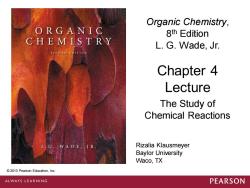
Organic Chemistry, ORGANIC 8th Edition CHEMISTRY L.G.Wade,Jr. Chapter 4 Lecture The Study of Chemical Reactions G.WADE,JR Rizalia Klausmeyer Baylor University Waco,TX 2013 Pearson Education,Inc. ALWAYS LEARNING PEARSON
© 2013 Pearson Education, Inc. Chapter 4 Lecture Organic Chemistry, 8 th Edition L. G. Wade, Jr. The Study of Chemical Reactions © 2013 Pearson Education, Inc. Rizalia Klausmeyer Baylor University Waco, TX
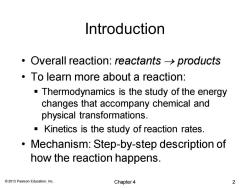
Introduction ·Overall reaction:reactants→products To learn more about a reaction: Thermodynamics is the study of the energy changes that accompany chemical and physical transformations. Kinetics is the study of reaction rates. Mechanism:Step-by-step description of how the reaction happens. 2013 Pearson Education,Inc. Chapter 4 2
© 2013 Pearson Education, Inc. Introduction • Overall reaction: reactants → products • To learn more about a reaction: ▪ Thermodynamics is the study of the energy changes that accompany chemical and physical transformations. ▪ Kinetics is the study of reaction rates. • Mechanism: Step-by-step description of how the reaction happens. Chapter 4 2
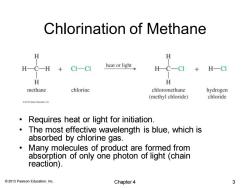
Chlorination of Methane H H一C-H CI-CI heat or light H- H-CI H H methane chlorine chloromethane hydrogen (methyl chloride) chloride 201 Peasn Eamon re Requires heat or light for initiation. The most effective wavelength is blue,which is absorbed by chlorine gas. Many molecules of product are formed from absorption of only one photon of light(chain reaction). 2013 Pearson Education,Inc. Chapter 4 3
© 2013 Pearson Education, Inc. Chlorination of Methane • Requires heat or light for initiation. • The most effective wavelength is blue, which is absorbed by chlorine gas. • Many molecules of product are formed from absorption of only one photon of light (chain reaction). Chapter 4 3
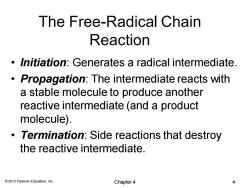
The Free-Radical Chain Reaction Initiation:Generates a radical intermediate. Propagation:The intermediate reacts with a stable molecule to produce another reactive intermediate(and a product molecule). Termination:Side reactions that destroy the reactive intermediate. 2013 Pearson Education,Inc. Chapter 4 4
© 2013 Pearson Education, Inc. The Free-Radical Chain Reaction • Initiation: Generates a radical intermediate. • Propagation: The intermediate reacts with a stable molecule to produce another reactive intermediate (and a product molecule). • Termination: Side reactions that destroy the reactive intermediate. Chapter 4 4
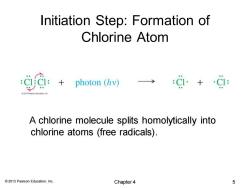
Initiation Step:Formation of Chlorine Atom ga: :+photon (hv)) A chlorine molecule splits homolytically into chlorine atoms (free radicals). 2013 Pearson Education,Inc. Chapter4 5
© 2013 Pearson Education, Inc. Initiation Step: Formation of Chlorine Atom A chlorine molecule splits homolytically into chlorine atoms (free radicals). Chapter 4 5
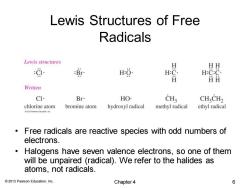
Lewis Structures of Free Radicals Lewis structures 效 H HH H H:C:C ⅱ丑 Written CI. Br. HO. CH3 CHCH2 chlorine atom bromine atom hydroxyl radical methyl radical ethyl radical Free radicals are reactive species with odd numbers of electrons. Halogens have seven valence electrons,so one of them will be unpaired (radical).We refer to the halides as atoms,not radicals. 2013 Pearson Education,Inc. Chapter 4 6
© 2013 Pearson Education, Inc. Lewis Structures of Free Radicals • Free radicals are reactive species with odd numbers of electrons. • Halogens have seven valence electrons, so one of them will be unpaired (radical). We refer to the halides as atoms, not radicals. Chapter 4 6
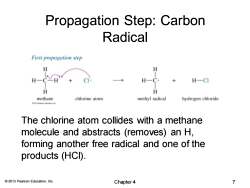
Propagation Step:Carbon Radical First propagation step H H H-日 H H-CI H methane chlorine atom methyl radical hydrogen chloride The chlorine atom collides with a methane molecule and abstracts (removes)an H, forming another free radical and one of the products (HCI). 2013 Pearson Education,Inc. Chapter4 7
© 2013 Pearson Education, Inc. Propagation Step: Carbon Radical The chlorine atom collides with a methane molecule and abstracts (removes) an H, forming another free radical and one of the products (HCl). Chapter 4 7
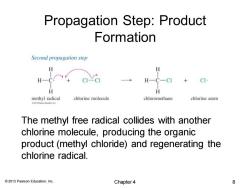
Propagation Step:Product Formation Second propagation step H H H H CI. H H methyl radical chlorine molecule chloromethane chlorine atom The methyl free radical collides with another chlorine molecule,producing the organic product(methyl chloride)and regenerating the chlorine radical. 2013 Pearson Education,Inc. Chapter 4 8
© 2013 Pearson Education, Inc. Propagation Step: Product Formation The methyl free radical collides with another chlorine molecule, producing the organic product (methyl chloride) and regenerating the chlorine radical. Chapter 4 8
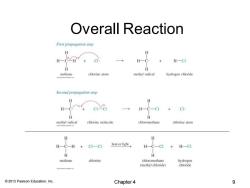
Overall Reaction First propagation step H H-CCH H-CI chlorine atom methyl radical hydrogen chloride Second propagation step H H H-C. H-C-CI H H methyl radical chlorine molecule chloromethane chlorine atom H-C—H+CI-C heat or light H-CI H H methane chlorine chloromethane hydrogen (methyl chloride) chloride n 2013 Pearson Education,Inc. Chapter 4 9
© 2013 Pearson Education, Inc. Overall Reaction Chapter 4 9
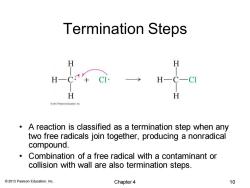
Termination Steps H H一C H H H 013 Pearson Educalion,ine A reaction is classified as a termination step when any two free radicals join together,producing a nonradical compound. 。 Combination of a free radical with a contaminant or collision with wall are also termination steps. 2013 Pearson Education,Inc. Chapter 4 10
© 2013 Pearson Education, Inc. Termination Steps • A reaction is classified as a termination step when any two free radicals join together, producing a nonradical compound. • Combination of a free radical with a contaminant or collision with wall are also termination steps. Chapter 4 10
按次数下载不扣除下载券;
注册用户24小时内重复下载只扣除一次;
顺序:VIP每日次数-->可用次数-->下载券;
- 《有机化学》课程PPT教学课件(Official PPT of Organic Chemistry, 8th Edition, L. G. Wade, Jr.Pearson Education)Chapter 16 Aromatic Compounds.ppt
- 《有机化学》课程PPT教学课件(Official PPT of Organic Chemistry, 8th Edition, L. G. Wade, Jr.Pearson Education)Chapter 15 Conjugated Systems, Orbital Symmetry, and Ultraviolet Spectroscopy.ppt
- 《有机化学》课程PPT教学课件(Official PPT of Organic Chemistry, 8th Edition, L. G. Wade, Jr.Pearson Education)Chapter 08 Reactions of Alkenes.ppt
- 《有机化学》课程PPT教学课件(Official PPT of Organic Chemistry, 8th Edition, L. G. Wade, Jr.Pearson Education)Chapter 07 Structure and Synthesis of Alkenes.ppt
- 《有机化学》课程PPT教学课件(Official PPT of Organic Chemistry, 8th Edition, L. G. Wade, Jr.Pearson Education)Chapter 06 Alkyl Halides - Nucleophilic Substitution and Elimination.ppt
- 《有机化学》课程PPT教学课件(Official PPT of Organic Chemistry, 8th Edition, L. G. Wade, Jr.Pearson Education)Chapter 05 Stereochemistry.ppt
- 《有机化学》课程PPT教学课件(Official PPT of Organic Chemistry, 8th Edition, L. G. Wade, Jr.Pearson Education)Chapter 03 Structure and Stereochemistry of Alkanes.ppt
- 《有机化学》课程PPT教学课件(Official PPT of Organic Chemistry, 8th Edition, L. G. Wade, Jr.Pearson Education)Chapter 02 Structure and Properties of Organic Molecules.ppt
- 《有机化学》课程PPT教学课件(Official PPT of Organic Chemistry, 8th Edition, L. G. Wade, Jr.Pearson Education)Chapter 01 Introduction and Review.ppt
- 《有机化学》课程PPT教学课件(Official PPT of Organic Chemistry, 7th Edition, L. G. Wade, Jr.Pearson Education)Chapter 26 Synthetic Polymers.ppt
- 《有机化学》课程PPT教学课件(Official PPT of Organic Chemistry, 7th Edition, L. G. Wade, Jr.Pearson Education)Chapter 25 Lipids.ppt
- 《有机化学》课程PPT教学课件(Official PPT of Organic Chemistry, 7th Edition, L. G. Wade, Jr.Pearson Education)Chapter 24 Amino Acids, Peptides, and Proteins.ppt
- 《有机化学》课程PPT教学课件(Official PPT of Organic Chemistry, 7th Edition, L. G. Wade, Jr.Pearson Education)Chapter 23 Carbohydrates and Nucleic Acids.ppt
- 《有机化学》课程PPT教学课件(Official PPT of Organic Chemistry, 7th Edition, L. G. Wade, Jr.Pearson Education)Chapter 22 Condensations and Alpha Substitutions of Carbonyl Compounds.ppt
- 《有机化学》课程PPT教学课件(Official PPT of Organic Chemistry, 7th Edition, L. G. Wade, Jr.Pearson Education)Chapter 21 Part 1 - Structure and Properties of Carboxylic Acid Derivatives.ppt
- 《有机化学》课程PPT教学课件(Official PPT of Organic Chemistry, 7th Edition, L. G. Wade, Jr.Pearson Education)Chapter 20 Carboxylic Acids.ppt
- 《有机化学》课程PPT教学课件(Official PPT of Organic Chemistry, 7th Edition, L. G. Wade, Jr.Pearson Education)Chapter 19 Amines.ppt
- 《有机化学》课程PPT教学课件(Official PPT of Organic Chemistry, 7th Edition, L. G. Wade, Jr.Pearson Education)Chapter 18 Ketones and Aldehydes.ppt
- 《有机化学》课程PPT教学课件(Official PPT of Organic Chemistry, 7th Edition, L. G. Wade, Jr.Pearson Education)Chapter 17 Reactions of Aromatic Compounds.ppt
- 《有机化学》课程PPT教学课件(Official PPT of Organic Chemistry, 7th Edition, L. G. Wade, Jr.Pearson Education)Chapter 16 Aromatic Compounds.ppt
- 《有机化学》课程PPT教学课件(Official PPT of Organic Chemistry, 8th Edition, L. G. Wade, Jr.Pearson Education)Reaction Mechanism and Synthesis Review.ppt
- 《有机化学》课程PPT教学课件(Organic Chemistry with Biological Applications, 3th Edition, John McMurry, 2016)Chapter 01 Structure and Bonding.ppt
- 《有机化学》课程PPT教学课件(Organic Chemistry with Biological Applications, 3th Edition, John McMurry, 2016)Chapter 02 Polar Covalent Bonds; Acids and Bases.ppt
- 《有机化学》课程PPT教学课件(Organic Chemistry with Biological Applications, 3th Edition, John McMurry, 2016)Chapter 03 Organic Compounds - Alkanes and Their Stereochemistry.ppt
- 《有机化学》课程PPT教学课件(Organic Chemistry with Biological Applications, 3th Edition, John McMurry, 2016)Chapter 04 Organic Compounds - Cycloalkanes and Their Stereochemistry.ppt
- 《有机化学》课程PPT教学课件(Organic Chemistry with Biological Applications, 3th Edition, John McMurry, 2016)Chapter 05 Stereochemistry at Tetrahedral Centers.pptx
- 《有机化学》课程PPT教学课件(Organic Chemistry with Biological Applications, 3th Edition, John McMurry, 2016)Chapter 06 An Overview of Organic Reactions.ppt
- 《有机化学》课程PPT教学课件(Organic Chemistry with Biological Applications, 3th Edition, John McMurry, 2016)Chapter 07 Alkenes and Alkynes.ppt
- 《有机化学》课程PPT教学课件(Organic Chemistry with Biological Applications, 3th Edition, John McMurry, 2016)Chapter 08 Reactions of Alkenes and Alkynes.ppt
- 《有机化学》课程PPT教学课件(Organic Chemistry with Biological Applications, 3th Edition, John McMurry, 2016)Chapter 09 Aromatic Compounds.ppt
- 《有机化学》课程PPT教学课件(Organic Chemistry with Biological Applications, 3th Edition, John McMurry, 2016)Chapter 11 Structure Determination - Nuclear Magnetic Resonance Spectroscopy.ppt
- 《有机化学》课程PPT教学课件(Organic Chemistry with Biological Applications, 3th Edition, John McMurry, 2016)Chapter 10 Structure Determination - Mass Spectrometry, Infrared Spectroscopy, and Ultraviolet Spectroscopy.ppt
- 《有机化学》课程PPT教学课件(Organic Chemistry with Biological Applications, 3th Edition, John McMurry, 2016)Chapter 12 Organohalides - Nucleophilic Substitutions and Eliminations.ppt
- 《有机化学》课程PPT教学课件(Organic Chemistry with Biological Applications, 3th Edition, John McMurry, 2016)Chapter 13 Alcohols, Phenols, and Thiols; Ethers and Sulfides.ppt
- 《有机化学》课程PPT教学课件(Organic Chemistry with Biological Applications, 3th Edition, John McMurry, 2016)Chapter 14 Aldehydes and Ketones - Nucleophilic Additions Reactions.ppt
- 《有机化学》课程PPT教学课件(Organic Chemistry with Biological Applications, 3th Edition, John McMurry, 2016)Chapter 15 Carboxylic Acids and Nitriles.ppt
- 《有机化学》课程PPT教学课件(Organic Chemistry with Biological Applications, 3th Edition, John McMurry, 2016)Chapter 16 Carboxylic Acid Derivatives - Nucleophilic Acyl Substitution Reactions.ppt
- 《有机化学》课程PPT教学课件(Organic Chemistry with Biological Applications, 3th Edition, John McMurry, 2016)Chapter 17 Carbonyl Alpha-Substitution and Condensation Reactions.ppt
- 《有机化学》课程PPT教学课件(Organic Chemistry with Biological Applications, 3th Edition, John McMurry, 2016)Chapter 18 Amines and Heterocycles.ppt
- 《有机化学》课程PPT教学课件(Organic Chemistry with Biological Applications, 3th Edition, John McMurry, 2016)Chapter 19 Biomolecules - Amino Acids, Peptides, and Proteins.ppt
